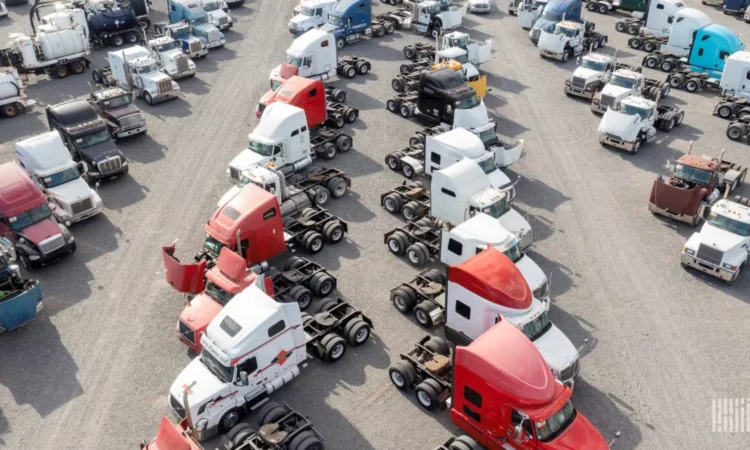Retail prices for older equipment still in nosebleed territory
Used truck auction prices dipped in April as freight demand softened, but the doubling in cost of acquiring low-mileage pre-owned equipment over the last year will take months to return to anything resembling normal.
And even with the peak crested, prices will be much higher than the historic gap between new and used Class 8 tractors, according to J.D. Power Valuation Services.
“Pricing is still extremely high by historical standards — particularly for the newest trucks available — but [auction] hammer prices for all trucks sold in April 2022 and early May 2022 were noticeably lower than earlier in the year,” Power said in its latest Guidelines newsletter.
A 3% month-over-month increase for 2018 models contrasted declines of 3.7%, 4.2% and 19.8% for 2020, 2019 and 2017 model year sleeper cabs. The big dip for 2017 models correlated with a mix of less-equipped trucks and a small sample size.
“Year-to-date, 4- to 6-year-old sleepers have depreciated 6.9% per month on average, but that includes the less-valid 2017 result,” Power reported.
“As we suspected, the relationship between the freight environment and truck supply is looking different as we enter the second half of the year. We predicted strong used truck pricing through the first half, and while pricing is still strong by historical standards, the initial correction happened a month or two earlier than anticipated — at least in the auction channel.”
Canada-based auction house Ritchie Brothers said February-to-April prices for used truck tractors increased 52% compared to the same time frame last year. Tractor pricing outstripped the rate of increase for all other vocational and earthmoving equipment.
Cauldron of woes for freight industry
The end of individual stimulus checks, rising interest rates, increased inventories, a fully functioning service industry prompted by widespread return-to-office policies and spiking inflation are combining to cause the freight environment to pull back from white-hot conditions.
And that means fewer frenetic auctions where bidders are willing to pay up to get a used truck.
In the 11 years between the end of the Great Recession and the beginning of the COVID-19 pandemic, the typical 4-year-old sleeper tractor sold at auction between $30,000 and $50,000 depending on the point in trucking’s traditional boom-and-bust cycles.
That same 4-year-old sleeper peaked at about $118,000 early this year — about 136% above the highest pre-pandemic peak.
“Hopefully, no one thought a 130%+ increase in pricing during the span of 18 months was the permanent new normal, and we’ve certainly advised clients since day one to be prepared for an eventual pullback towards trend,” Power wrote.
New truck deliveries strengthened in March and April, allowing fleets to step up trade-ins of older equipment they had been keeping as a hedge against the paucity of new trucks available. Prices of used trucks will fall as inventories rise and the economy contracts.
“We have no way of knowing if future months will hit and sustain the mid-20,000 range required to fulfill the orders of the past 18 months — or if buyers will still want 100% of those orders — but we’re assuming production will look somewhat healthier in 2022 than 2021,” Power wrote.
Retail prices holding higher for now
Retail selling prices usually trail auction prices by two to three months as they adjust to market shifts. In April, buyers still paid near historic high prices.
“The market shift in the auction channel had not yet spilled over to the retail channel in April, although slightly cooler demand may have played a role in this month’s results for the first time since 2020,” Power said.
Preliminary Class 8 sales at dealerships fell 40% month over month. They were down 33% compared to April 2021, according to ACT Research. Prices rose 10% month over month but both the age of the trucks and the miles on the odometer were lower.
“Looking ahead, if April is not the peak for prices, then the zenith cannot be far off,” said Steve Tam, ACT Research vice president. “Slowing freight and freight rates confirm the assertion.”


